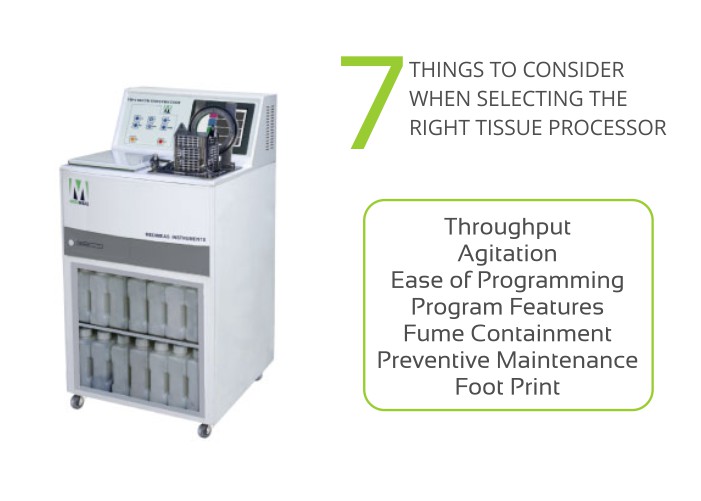
There are seven things to consider when selecting the right Tissue Processor, they are as follows:
Throughput
The number of tissue samples you plan to process in a day determines the capacity and type (vacuum or non-vacuum) of tissue processor that you should be considering. Vacuum Tissue Processors are more efficient and can achieve the same infiltration in a lesser time than non-vacuum types. The processing capacity is generally mentioned in terms of number of tissue cassettes that the processing container can hold in one load. Check to see the options available for your requirement.
Agitation
To enhance the mass transfers between the tissue and the reagent a continuous relative movement between the two is required. Check to see if the tissue processor under consideration could do the same.
| Tissue Processor Type | Agitation |
| Carousel bench top | Circular motion of the basket |
| Linear bench top | Linear vibration of the basket |
| Vacuum Moving Reagent Floor Standing | Magnetic Stirrer in the retort |
Ease of Programming
The tissue processing cycle, i.e. the time the tissue sample spends in different reagent containers/wax baths can be programmed as per user requirement. This programming can be done through mechanical pin-up timers or through a microprocessor controlled software. The choice depends on the ease-of-use and the equipment budget. Software programming is easy to use than pin-up timers but comes at increased costs. The other advantage of a software programming is that it has program memory which can store multiple running programmes, so that the user does not have to feed programs again and again.
Additional Program Features
Check to see if the equipment has built-in safety features like prevention of tissues transfer to an unmelted wax bath. Delay start functions enables to program the cycle upfront but delays the start of the cycle, this feature is helpful when the user wants to get the cycle started before the lab start time, so that when he comes to lab the tissues are already processed. Other features include end cycle alarms, low reagent alarms, auto cleaning cycles etc.
Fume Containment
Tissue Processsors use reagents that emit fumes when left open. Check to see how does the equipment contain these fumes. For carousel type models, there is a lid that sits on-top of the regent containers, this can cut down the reagent loss significantly. Moreover, if one needs to completely make the lab environment fumes-free, one may opt for an optional fume control system for carousel type models. The linear and floor standing models are better in controlling fumes as their standard models have a completely enclosed processing area that contains all the fumes.
Preventive Maintenance Procedures
Ask for preventive maintenance procedures for the equipment. Check to see if these procedures are simple or complex and the required frequency of the same. The models with easy procedures would be best suited.
Foot Print
If you have small laboratory space, the foot print of the tissue processor will become important. Carousel type models cover smaller area than linear models.